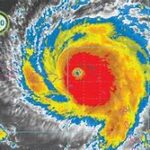My regular readers know that I have been fussing about the threat of hurricanes destroying proposed Atlantic coast offshore wind arrays. The issue arises because the offshore wind industry is based in Europe, which does not get hurricanes. My focus has been Dominion’s massive project off Virginia, but the whole East Coast is hurricane alley.
Now I have found some research that actually quantifies the threat and it is very real. It looks like wind generators will have to be redesigned specifically to withstand hurricanes. In fact, that work is underway. In the meantime we should not be building conventional offshore wind towers.
The 2017 press release is succinctly titled, “Offshore wind turbines vulnerable to Category 5 hurricane gusts.” The PR says this: “The study, which was conducted in collaboration with the National Center for Atmospheric Research in Boulder, Colorado, and the U.S. Department of Energy’s National Renewable Energy Laboratory in Golden, Colorado, highlights the limitations of current turbine design and could provide guidance for manufacturers and engineers looking to build more hurricane-resilient turbines in the future.”
We certainly want hurricane-resilient turbines! Actually, they also mean towers and blades, not just the turbines. It is the towers and blades that are most likely to collapse in extreme wind, although the turbines can be damaged as well.
The research report itself has a more specific but equally scary title: “Gusts and shear within hurricane eyewalls can exceed offshore wind turbine design standards.” Mind you, what they did is computer modeling. But what they found confirms prior observations that people were having trouble believing.
Simply put, they found that hurricane wind gusts can hit an incredible 200 miles per hour, while wind towers are only designed to withstand 160 mph. If those extreme gusts hit an offshore wind farm, catastrophe is pretty much guaranteed.
In addition to extremely damaging gusts, the press release says this: “Furthermore, current standards do not account for veer, a measure of the change in wind direction across a vertical span. In the simulation, wind direction changed by as much as 55 degrees between the tip of the rotor and its hub, creating a potentially dangerous strain on the blade.”
Here is how they make the fundamental point:
The findings could be used to help wind farm developers improve design standards as well as to help stakeholders make informed decisions about the costs, benefits and risks of placing turbines in hurricane-prone areas.
I have yet to see any sort of hurricane risk assessment from any of the proposed East Coast wind projects, most of which involve many billions of dollars. In the Virginia case the primary stakeholders are the ratepayers who are on the hook for an estimated ten billion dollars. In their case hurricanes have not even been mentioned by Dominion.
A more recent article comes to similar conclusions — “Hurricane eyewall winds and structural response of wind turbines.” The article is technical but here is their plain language summary:
Offshore wind energy is a burgeoning area of renewable energy that is at an early stage of development in the United States. Exposure of offshore wind turbines to hurricanes must be assessed and mitigated to ensure the security of the renewable energy supply. This research assesses the impact of hurricane wind fields on the structural response of wind turbines. Such wind fields have characteristics that may pose heretofore unforeseen structural challenges to offshore wind turbines.
I have not done a literature search but there may well be a large literature on this huge problem. If so, then the wind developers are carefully ignoring it.
Before we build tens or hundreds of billions of dollars worth of massive offshore wind facilities off the East Coast we need to be sure that they will withstand strong hurricanes. (It may well be that even Category 4 hurricanes will exceed today’s design standards.) Otherwise both the ratepayers and the grid will be at great risk.
This hurricane design case may be something that NERC should Issue a Reliability Standard on. Such a Reliability Standard would lay out the kind of hurricane risk assessment that must be done as part of the facility design process. These risk assessments need to then be made part of the public decision process.
Offshore wind should not fly blindly into the teeth of the storm. Too much is at risk.
David Wojick, Ph.D. is an independent analyst working at the intersection of science, technology and policy. He has been on the faculty of Carnegie Mellon University and the staffs of the U.S. Office of Naval Research and the Naval Research Lab. This article was originally published at cfact.org.


Leave a Reply
You must be logged in to post a comment.